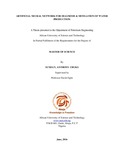| dc.description.abstract | From the inception of the oil and gas industry, water production has always been an aching problem for various operators. Throughout the productive life of a field, oil production is often accompanied with some amount of water production, which in most cases, is so significant and unwanted. Because of the great operating, environmental and economic challenges associated with excess water production, operators are in search for different methods and tools that could be used to identify the sources of water and prevent or mitigate early water breakthrough in producing oil and gas wells.
In this study, artificial neural network (ANN) models were developed and used as reservoir management tools to proffer solution to mitigate excess water production problems. Two cases were considered to build and train the network models. In case one, three neural network models were developed and optimized by training with data from only one producing well. The built network models are called CASNNET1, CASNNET2, and CASNNET3, respectively. In case two, a neural network model called CASNNET4 was developed by using combined data from two producing wells for training, validation and testing.
The neural network models in both cases were developed to predict well water cut with an appreciable degree of accuracy. The accuracy of the models was generalized by testing the trained and optimized network models on unseen data from the other four wells in the same reservoir. The generalization of the network shows that CASNNET1, CASNNET2, CASNNET3, and CASNNET4 have predictive capacities of approximately 92.2%, 86.42%, 88.18% and 79.29%, respectively. Finally, the neural network model results were used jointly with reservoir simulation results to suggest possible ways of preventing or mitigating excess water production. | en_US |

